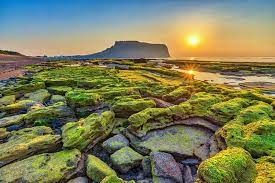Korean art is getting its turn in the spotlight as notable art institutions and galleries are starting to showcase more works from Korean artists, particularly those who specialize in modern or contemporary art. Earlier this year, David Zwirner, a leading gallery in Paris, held an exhibition of the late Yun Hyong-keun's rare and never-before presented seen paintings from January 7 to February 23. The paintings are considered to be part of the artist's experimental phase since Yun is known best for his "dansaekwha" or monochrome paintings. Meanwhile, New York's Rockefeller Center is currently holding an exhibition called "Origin, Emergence, Return" which features the works of three Korean artists.
It's clear to see that just as the world has embraced K-dramas, K-pop, and K-beauty with open arms, there's also room for contemporary Korean art to flourish in the global art scene. Along with classical Korean art forms, modern art celebrates Korean culture in unique and colorful ways. Get to know some of the Korean artists who are shaping modern art.
Yoo Young-ho
Some of the most famous art installations crafted from metal such as the Red Cube in Lower Manhattan and The Four Elements in Stockholm provide a sense of whimsy to a space and they give joy to lots of people. The same can be said about the "Greetingman Project," which is a sculpture depicting a 6-meter tall man, who bows to the viewer as a sign of friendship. This was created by Yoo Young-ho, a sculptor who was awarded the Kim Sejong Scripture Award for Young Sculptors in 2004.
Yoo intends to promote peace with his art, and it's why he chose to erect the statues in locations like the DMZ, Panama, Vietnam, Ecuador, Uruguay, Peru, and the border between Palestine and Israel. In an interview, Yoo said that he chose to color the sculpture blue because "when people see this color they may feel joy and light." The artist is reportedly planning to add about 1,000 more Greetingman statues all over the world.
Park Seo-Bo
Park Seo-Bo is one of the artists currently featured in the Rockefeller Center exhibition which was mentioned earlier. The 91-year-old is an iconic figure in Korean contemporary art as he is one of those who defined the dansaekwha movement. While he's best known for his large scale minimalist paintings, he's also famous in the Korean art scene for using unconventional techniques, such as burning the surface of his works with a blowtorch. He also uses traditional Korean kanji paper in his art, often layering them on top of paintings. Park founded the Seo-bo Art and Culture, and two museums are currently being constructed to house his works.
Nam June Paik
Nam June Paik was a Korean-American artist who was known as the Father of Video Art. His impressive body of work includes videotapes and video sculptures such as "TV Buddha," and installations like "Video Fish" and "TV Garden." The artist passed away in 2006, and while digital art has become more popular these days, those in the art world know that Nam's contribution to modern art should never be forgotten. As a result, a new documentary titled "Nam June Paik: Moon Is The Oldest TV" was shown at Sundance earlier this year, and it details his dedication to his craft. Though Nam once famously said that he uses technology in order to hate it properly, he foresaw the possibilities of using technology to create art, and now, artists are using different types of tech to make their masterpieces.
Korean art is evolving and is attracting a larger audience worldwide. These masters of modern Korean art remind us that with innovation, creativity, and heart, one can make art that moves and inspires us in different aspects of our lives. Korean art is getting its turn in the spotlight as notable art institutions and galleries are starting to showcase more works from Korean artists, particularly those who specialize in modern or contemporary art. Earlier this year, David Zwirner, a leading gallery in Paris, held an exhibition of the late Yun Hyong-keun's rare and never-before presented seen paintings from January 7 to February 23. The paintings are considered to be part of the artist's experimental phase since Yun is known best for his "dansaekwha" or monochrome paintings. Meanwhile, New York's Rockefeller Center is currently holding an exhibition called "Origin, Emergence, Return" which features the works of three Korean artists.
It's clear to see that just as the world has embraced K-dramas, K-pop, and K-beauty with open arms, there's also room for contemporary Korean art to flourish in the global art scene. Along with classical Korean art forms, modern art celebrates Korean culture in unique and colorful ways. Get to know some of the Korean artists who are shaping modern art.
Yoo Young-ho
Some of the most famous art installations crafted from metal such as the Red Cube in Lower Manhattan and The Four Elements in Stockholm provide a sense of whimsy to a space and they give joy to lots of people. The same can be said about the "Greetingman Project," which is a sculpture depicting a 6-meter tall man, who bows to the viewer as a sign of friendship. This was created by Yoo Young-ho, a sculptor who was awarded the Kim Sejong Scripture Award for Young Sculptors in 2004.
Yoo intends to promote peace with his art, and it's why he chose to erect the statues in locations like the DMZ, Panama, Vietnam, Ecuador, Uruguay, Peru, and the border between Palestine and Israel. In an interview, Yoo said that he chose to color the sculpture blue because "when people see this color they may feel joy and light." The artist is reportedly planning to add about 1,000 more Greetingman statues all over the world.
Park Seo-Bo
Park Seo-Bo is one of the artists currently featured in the Rockefeller Center exhibition which was mentioned earlier. The 91-year-old is an iconic figure in Korean contemporary art as he is one of those who defined the dansaekwha movement. While he's best known for his large scale minimalist paintings, he's also famous in the Korean art scene for using unconventional techniques, such as burning the surface of his works with a blowtorch. He also uses traditional Korean kanji paper in his art, often layering them on top of paintings. Park founded the Seo-bo Art and Culture, and two museums are currently being constructed to house his works.
Nam June Paik
Nam June Paik was a Korean-American artist who was known as the Father of Video Art. His impressive body of work includes videotapes and video sculptures such as "TV Buddha," and installations like "Video Fish" and "TV Garden." The artist passed away in 2006, and while digital art has become more popular these days, those in the art world know that Nam's contribution to modern art should never be forgotten. As a result, a new documentary titled "Nam June Paik: Moon Is The Oldest TV" was shown at Sundance earlier this year, and it details his dedication to his craft. Though Nam once famously said that he uses technology in order to hate it properly, he foresaw the possibilities of using technology to create art, and now, artists are using different types of tech to make their masterpieces.
Korean art is evolving and is attracting a larger audience worldwide. These masters of modern Korean art remind us that with innovation, creativity, and heart, one can make art that moves and inspires us in different aspects of our lives.
 Electric Lamp with a Mirror and a Figurine
Electric Lamp with a Mirror and a FigurineComing from an African country, many would assume that South Africans are comfortable with the heat. My assumption was that - Jeju Island will never get as hot as South Africa, but it sure does! It gets quite humid too, so preparing for the weather is very important. Summer is synonymous with heat and sun, but another important factor that needs to be considered with the weather on Jeju Island is the rain. Oh, it POURS! I use public transport which is extremely efficient, so every time it rains, I need to make sure I am geared up.
In keeping up with summer, I would recommend the following:
Here are some tips to get you by:
Lastly, stay positive! The shock of how different the weather is can be overwhelming but you just have to understand it, be ready, and embrace it.
 Jeju
Jeju